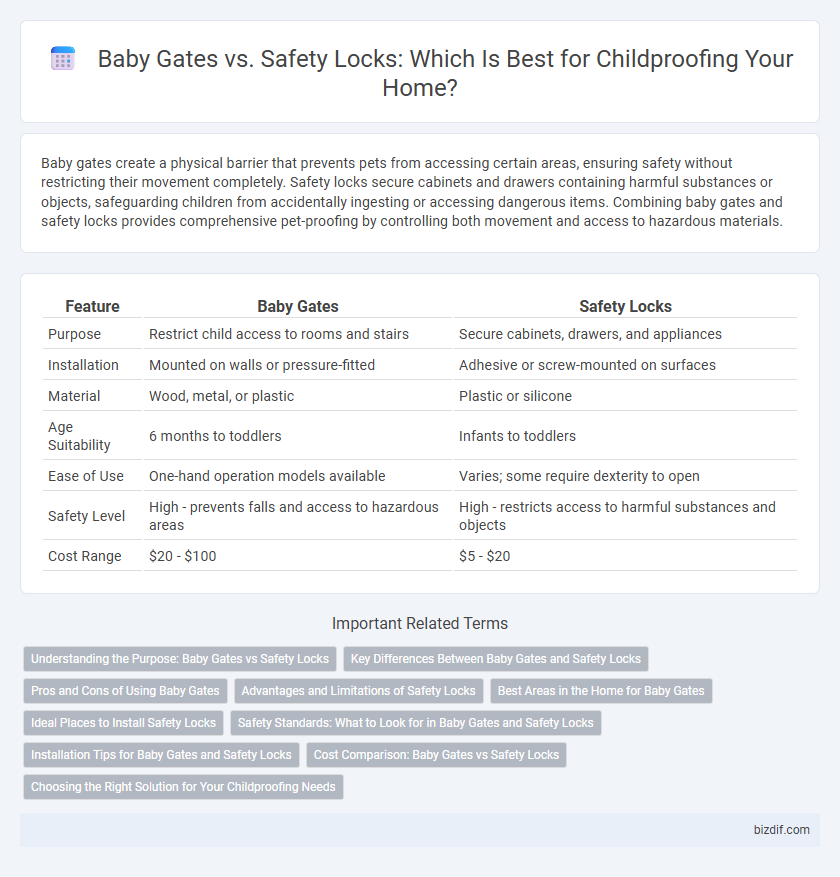Baby gates create a physical barrier that prevents pets from accessing certain areas, ensuring safety without restricting their movement completely. Safety locks secure cabinets and drawers containing harmful substances or objects, safeguarding children from accidentally ingesting or accessing dangerous items. Combining baby gates and safety locks provides comprehensive pet-proofing by controlling both movement and access to hazardous materials.
Table of Comparison
| Feature | Baby Gates | Safety Locks |
|---|---|---|
| Purpose | Restrict child access to rooms and stairs | Secure cabinets, drawers, and appliances |
| Installation | Mounted on walls or pressure-fitted | Adhesive or screw-mounted on surfaces |
| Material | Wood, metal, or plastic | Plastic or silicone |
| Age Suitability | 6 months to toddlers | Infants to toddlers |
| Ease of Use | One-hand operation models available | Varies; some require dexterity to open |
| Safety Level | High - prevents falls and access to hazardous areas | High - restricts access to harmful substances and objects |
| Cost Range | $20 - $100 | $5 - $20 |
Understanding the Purpose: Baby Gates vs Safety Locks
Baby gates serve as physical barriers to prevent toddlers from accessing stairways or hazardous rooms, ensuring safe play areas. Safety locks focus on restricting access to cabinets, drawers, or appliances, protecting children from harmful substances and dangerous items. Both tools are essential in a comprehensive childproofing strategy, addressing distinct safety concerns within the home environment.
Key Differences Between Baby Gates and Safety Locks
Baby gates create physical barriers to restrict a child's access to specific areas like stairs or rooms, offering visible and immediate protection. Safety locks secure cabinets, drawers, and appliances to prevent children from opening potentially dangerous items, focusing on internal access control rather than area exclusion. The key difference lies in baby gates controlling movement through spaces, while safety locks limit access to individual objects or storage units.
Pros and Cons of Using Baby Gates
Baby gates provide a reliable barrier to prevent toddlers from accessing stairs or hazardous areas, enhancing home safety and reducing accident risks. They are easy to install, adjustable to various doorways, and allow visibility, but may limit adult movement and can be bypassed by determined children. Compared to safety locks, baby gates offer broader area restriction but less precise control over specific cabinets or drawers.
Advantages and Limitations of Safety Locks
Safety locks for childproofing provide a secure and discreet solution to prevent toddlers from accessing cabinets, drawers, and appliances, enhancing home safety without compromising aesthetics. Their main advantage lies in easy installation and adaptability across various furniture types, though they may require frequent adjustments or replacement due to wear and tear. Limitations include potential difficulty in operation for some adults and less effectiveness on furniture with unconventional shapes or surfaces.
Best Areas in the Home for Baby Gates
Baby gates are most effective in high-traffic areas such as staircases, doorways leading to kitchens, and rooms with hazardous items to prevent infants from accessing dangerous spaces. Safety locks are ideal for cabinets, drawers, and appliances to secure potentially harmful objects, but gates provide a physical barrier in larger, open spaces where containment is necessary. Stairways and entry points to basements or garages are critical zones where baby gates offer superior protection by restricting mobility and reducing the risk of falls or injuries.
Ideal Places to Install Safety Locks
Safety locks are ideal for securing cabinets, drawers, and appliances where hazardous items such as cleaning supplies, sharp utensils, or medications are stored. Installing safety locks on bathroom cabinets and kitchen cupboards helps prevent toddlers from accessing harmful substances. These locks are also effective on laundry rooms and storage closets to maintain a child-safe environment throughout the home.
Safety Standards: What to Look for in Baby Gates and Safety Locks
When selecting baby gates and safety locks, prioritize products that comply with ASTM F1004 and JPMA certification for gates, ensuring durability and secure installation. Safety locks should meet the CPSC safety guidelines and feature tamper-resistant designs to prevent accidental removal by children. Look for gates with vertical slats spaced no more than 2 3/8 inches apart and locks with strong adhesive or screw-in mechanisms to guarantee reliable childproofing effectiveness.
Installation Tips for Baby Gates and Safety Locks
Secure baby gates by measuring doorways accurately and anchoring hardware firmly into wall studs for maximum stability. When installing safety locks, clean surfaces thoroughly and follow manufacturer guidelines to ensure adhesives bond properly and locks function reliably. Regularly check and adjust both baby gates and safety locks to maintain effective childproofing as your child grows.
Cost Comparison: Baby Gates vs Safety Locks
Baby gates typically cost between $30 and $150 depending on size, material, and brand, offering a durable barrier for staircases and doorways. Safety locks range from $5 to $25, providing a more affordable solution primarily for cabinets and drawers but with limited application compared to gates. Investing in baby gates is cost-effective for comprehensive area restriction, while safety locks serve as budget-friendly protection for specific access points.
Choosing the Right Solution for Your Childproofing Needs
Baby gates provide a physical barrier ideal for blocking stairways and large openings, ensuring toddlers cannot access hazardous areas, while safety locks secure cabinets and drawers containing dangerous items. Selecting the right childproofing solution depends on the specific risks in your home environment and the age and mobility of your child. Combining baby gates and safety locks often creates a comprehensive safety system tailored to diverse household hazards.
Baby gates vs Safety locks Infographic

 bizdif.com
bizdif.com